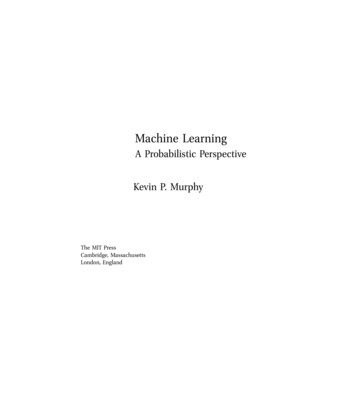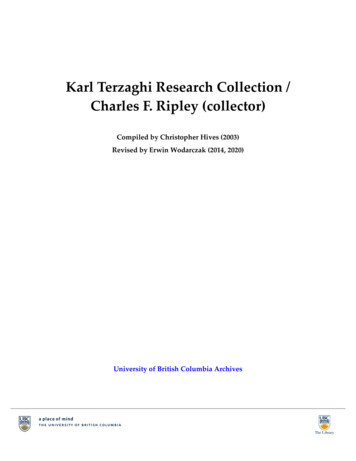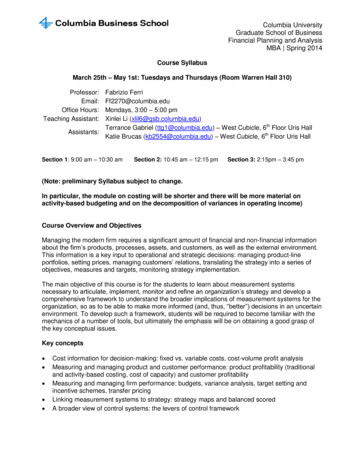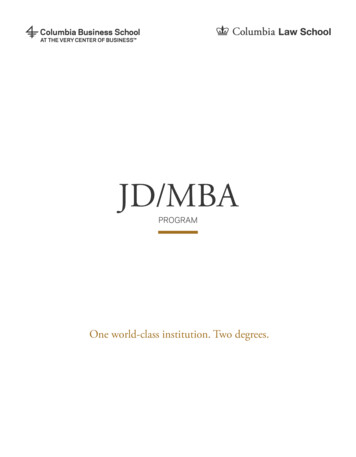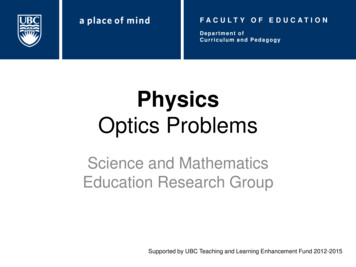
Transcription
F FAACC UULLTT Y OOFF EEU ATC AI OT INO NDDUCDepartment ofCurriculum and PedagogyPhysicsOptics ProblemsScience and MathematicsEducation Research GroupSupported by UBC Teaching and Learning Enhancement Fund 2012-2015
OpticsProblemsQuestionTitleRetrieved from: http://www.learnpedia.in/blog/optics/
OpticsProblemsQuestionTitleThe following questions have beencompiled from a collection ofquestions submitted on PeerWise(https://peerwise.cs.auckland.ac.nz/)by teacher candidates as part of theEDCP 357 physics methods coursesat UBC.
OpticsProblemsQuestionTitle IA ray of light enters three blocks (A, B, & C) of varied materialsand refracts as shown below. The index of refraction of the threeblocks are nA, nB, and nC respectively.
Optics Problems IQuestionTitlecontinuedWhich of the following is correct?Assume the rays each originate in air (ie. start in the samemedium).A. nA nB nCB. nB nC nAC. nB nA nCD. nA nB nCE. nC nB nA
SolutionQuestion TitleAnswer: DJustification: When a ray of light passes from one medium intoanother, it refracts depending on the comparative indexes of refractionof the first and second mediums. Let us call the first medium's index ofrefraction ni.If the two mediums have the same index of refraction, the ray willcontinue straight without refracting. If the second medium has a lowerindex of refraction, the ray will bend away from the normal (angle ofincidence angle of refraction). If the second medium has a higherindex of refraction, the ray will bend towards the normal (angle ofincidence angle of refraction).From the diagrams, we can therefore tell that nA ni , nB ni , and nC niSince the first medium in all three cases in the same (air), we can thentell that nA nB nC (answer D).
OpticsProblemsQuestionTitle IIIn geometric optics, the following statements are TRUE for realand virtual images:i.ii.If you capture sunlight in a mirror or lens you canfeel the heat where the sunlight isreflected/refracted as a real image but youcannot feel the heat where the sunlight isreflected/refracted as a virtual imageYou can project a real image onto a screen butyou cannot do so with a virtual imageiii. A diverging lens can create a real imageiv. A converging lens can create a real imagev.Both convex and concave mirrors can createreal imagesA. i, ii & iiiB. i, ii & ivC. i, iv & vD. iv & vE. iii & v
SolutionQuestion TitleAnswer: BJustification: First consider the line optics of real images (fromhttp://en.wikipedia.org/wiki/Real image):Convex LensConcave MirrorNotice that the lines that converge to form the image point are alldrawn solid. This means that they are actual rays, composed ofphotons originating at the source objects. If you put a screen in thefocal plane, light reflected from the object will converge on the screenand you'll get a luminous image (as in a cinema or a overheadprojector).
SolutionQuestioncontinuedTitleNext examine the situation for virtual images (fromhttp://en.wikipedia.org/wiki/Virtual image):Concave LensConvex MirrorNotice here that the image is formed by a one or more dashed lines(possibly with some solid lines). The dashed lines are draw off the backof solid lines and represent the apparent path of light rays from theimage to the optical surface, but no light from the object ever movesalong those paths. This light energy from the object is dispersed, notcollected and can not be projected onto a screen. There is still an
Solution2QuestioncontinuedTitle"image" there, because those dispersed rays all appear to be comingfrom the image. Thus, a suitable detector (like your eye) can "see" theimage, but it cannot be projected onto a screen.So, for the statements provided previously:i True. Since a real image is formed where actual light rays meet therewill be heat where the image is real. That is why converging lenses andconcave mirrors can start fires when sunlight is pointed to focus on acombustible object.ii True. As explained above.iii False. As explained above.iv True. As explained above.v False. Only concave mirrors can produce real images.Therefore, option B is the correct choice.
OpticsProblemsQuestionTitle IIISergai is a vain man. He loves to look at himself in the mirror allthe time. Unfortunately, his pet lion just broke his favourite mirror,and so Sergai is shopping for a new one.
Optics Problems IIIQuestionTitlecontinuedHow tall (h) would the new mirror have to be in order for Sergai,whose height is H, to be able to see his whole body if the distancebetween him and the mirror (d) ½H? What if d H?d ½Hd HA. h Hh ½HB. h Hh HC. h ½Hh HD. h ½Hh ½HE. h ½Hh ¼H
SolutionQuestion TitleAnswer: DJustification: When Sergai looks at the top of his head in the mirror,the light rays travel downwards from his head to the mirror, thendownwards to his eyes.When he looks at his feet, the light travels up to the mirror from hisfeet, then up to his eyes.θ1θ1θ2θ2
SolutionQuestioncontinuedTitleSince we know for both reflections the angle of incidence and the angleof reflection are the same (ɵ1 for the eyes and ɵ2 for the feet), and thatthe object being reflected and the observer are the same distance fromthe mirror (they are the same thing!), then we know that the light rayshave formed two pairs of identical isosceles triangles (in blue andgreen).θ1θ1θ2θ2
Solution2QuestioncontinuedTitleThe long (horizontal) leg of each triangle bisects the distance betweenthe object (head or foot) and the observer (eye), so we know that theshort (vertical) legs of the triangles are equal in length to half thedistance between their object and the eye (L1 and L2).θ1θ1½L1L1½L2θ2θ2L2
Solution3QuestioncontinuedTitleThe distance between the two points of reflection on the mirror istherefore: ½L1 ½L2Since we know that L1 L2 H, then we can get:½L1 ½L2 ½HSo the mirror has to be at least half as tall as Sergai in order for him tosee his whole body.You will notice that nowhere in our deduction of this answer did weconsider Sergai's distance from the mirror! This is because no matterhow close or how far from the mirror he stands, the same two pairs ofidentical, isosceles triangles will be formed, reflecting at the samepoints on the mirror, but with different angles of incidence/reflection.The mirror must be ½H tall no matter where Sergai stands, so theanswer is D.
OpticsProblemsQuestionTitle IVSergai decides to buy two mirrors in order to see himself better.Which arrangement should he put the two mirrors in in order to beable to see the most reflections of himself?A.B.C.D.
SolutionQuestion TitleAnswer: CJustification: A plane mirror will only produce one reflection. Option Ais essentially a single plane mirror, and will therefore only produce onereflection.Two mirrors perpendicular to one another(Option B) will produce three images: twoimages from single reflections (green andblue) and one from double reflection (red).In this image the object and observer areseparate to make the process clear. Itworks the same if the object and observerare the same, like in Sergai's case, butdiagrams of this are harder to draw clearly.
SolutioncontinuedQuestion TitleTwo mirrors angled at 60 degrees (Option C) will produce five images,two from single reflections, two from double reflections and onecomposite image.Images I1 and I2 are formed by thesingle reflection of the object onmirrors A and B, respectively.Images I3 and I4 are formed by thereflection of I1 and I2 on mirrors A andB (and their imaginary extensions, A'and B') respectively. This is the sameas the double reflection in option B.Image I5 is a composite image,created by the reflections of I3 and I4on mirrors A' and B' (notice that theycreate the same image – theyoverlap!).
SolutioncontinuedQuestion TitleTwo mirrors parallel to one another (Option D) will produce infiniteimages as the two mirrors continuously reflect the other mirror's image.So option D produces the most images.But the question asked for themost images that Sergai can see.And if Sergai is both the object andthe observer, he will not be able tosee the infinite reflection in D ashis body will block the images fromreflecting back and forth and theninto his eye.So then Option C, where there are5 visible images, is the best option.
OpticsProblemsQuestionTitle VA new type of transparent plastic has been developed. When lighttravels through it, it only travels at 2 107 m/s. What is therefractive index (n) of this new plastic?A. n 0.67B. n 1.5C. n 6.67D. n 15
SolutionQuestion TitleAnswer: DJustification: An object's index of refraction is described using Snell'sLaw, which relates the speed of light in a material to the speed of lightin a vacuum:Thus to find the refractive index of our new plastic, we need to dividethe speed of light in a vacuum (c), by the speed that light travels in themedium (v).It is important to remember our orders of magnitude, as the speed thatlight travels in this plastic is an order of 101 smaller than c, since weknow that c 300,000,000 m/s 3 108 m/s
SolutionQuestioncontinuedTitleTo find the refractive index:Therefore the correct answer is D.
Optics Problems VIQuestion TitleA beam of light is shone through the new plastic (from theprevious question) at a 30 degree angle from the normal. Assumethat we are testing this new plastic in a vacuum chamber. Usingyour knowledge of the refractive index from the previous question,which diagram most accurately represents how the light will berefracted in the new ºAirAirPlasticPlastic
SolutionQuestion TitleAnswer: AJustification: When light passes from one medium to another, such asfrom outside to inside our new plastic, the refractive index determineswhat angle it is bent at, following Snell's Law:We know that because the refractive index of the plastic, which wefound in the previous question to be 15, is (much) larger than that ofvacuum (which is 1), the light must be bent towards the normal. Thisimmediately rules out two possible answers, as in answer C, the light isnot refracted at all, and in answer D, the light is refracted away from thenormal.Thus, we can analyze answers A and B to determine the correct answer.We can deduce that A is the correct answer if we remember that arefractive index of 15 is extremely large, much larger than that found incommon materials (for example silicon only has a refractive index ofaround 3.45). Thus, the light will be refracted very close to the normal,and answer A is our correct answer.
SolutionQuestioncontinuedTitleIf we wanted to do an actual calculation to confirm our idea, we woulduse Snell's law as seen below:n1 1 (refractive index of a vacuum)Ɵ1 30ºn2 15Therefore we can see that A is the correct answer.
Question TitleOptics Problems The following questions have been compiled from a collection of questions submitted on PeerWise (https://peerwise.cs.auckland.ac.nz/) by teacher candidates as part of the
